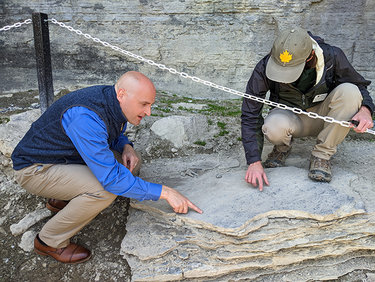On Earth Day, Thacher Park is celebrated as a National Natural Landmark with nearly $4M in upgrades announced
Under azure skies on Earth Day, a group of about 50 people gathered in the warm sun outside the visitor center to celebrate John Boyd Thacher State Park’s designation as a National Natural Landmark.
They had assembled for a plaque unveiling but, in addition to the plaque on the back, stone wall of the center, draped in festive scarlet, they were also greeted with three posters displayed on easels. Each pictured improvements totaling $3.9 million in state funds: a solar array, a warming hut, and upgrades to the park’s iconic Indian Ladder Trail.
The program concluded with a walk along the trail, covered solely by The Enterprise, as geologist Charles Ver Straeten and park educator Peter Farquharson enlightened the hikers on what they were seeing.
“It’s exciting; it’s deserved,” said geologist Nicholas Venti of the national designation. He and Ver Straeten had written the scientific report that led to the December designation.
It followed three decades of persistent work by Timothy Albright who grew up at the foot of the Helderberg escarpment and lives there still. Venti said he used a book co-authored by Albright in writing the report.
Albright, who was invited to the ceremony, and was commended by several of the speakers, was unable to attend as he was tending to his wife who had been hospitalized after suffering a seizure over the weekend.
In addition to the federal, state, and local officials who had gathered with park staff, Mike Vincent was there in a suit coat with a tie anchored by a park clip.
He spent his career working at the park, beginning in 1966. “I’m a farm boy,” the Hilltowner quipped. “We’re used to abuse. I started at the bottom and worked my way up.” He became the park’s maintenance supervisor and assistant manager.
Vincent recalled peeling cedar poles for the park’s fences, which he rebuilt more than twice. He is 75 now and said he hopes, after he dies, to have his ashes scattered at the park.
Deb DiQuinzio has had a 20 career with the National Natural Landmark program after a serendipitous encounter as an undergraduate at the University of Rhode Island. She is now the coordinator for the program in the Northeast.
In her two decades on the job, she said there has been a shift. “Now we’re looking to fill the gaps,” she said as the program seeks to tell the complete story of the Earth’s natural history, both biological and geological.
“Better parks build better community”
State Parks Commissioner Pro Tempore Randy Simons opened Monday’s ceremony, calling the day a trifecta: beautiful weather, the year of the State Parks centennial, and Earth Day.
He commended Albright as being “instrumental” in achieving the designation.
Looking out from the escarpment at the “crazy, hectic” city below, Simons said, “When you’re in this park … there’s a peace … I’m reconnecting, recharging.”
He commended the recently adopted state budget for supporting environmental causes and said, “It’s taking care of nature so nature can take care of us.”
Simons gave an overview of park history in the state, starting with the designation of Niagara Falls as the first state park in 1895.
In 1924, the State Parks Act provided oversight. “We finally had structure,” said Simons.
He urged the crowd to participate in the centennial celebration. “We’re asking for all your stories,” he said. “The impact that parks have had on our lives.”
Simons concluded, “Parks are the spirit of our communities, critical to our physical and mental well being.”
Lieutenant Governor Antonio Delgado started his speech by shouting, “Happy Earth Day.”
When he got a lukewarm response, he commanded, “C’mon!” and received shouts in return.
“It is fitting that Thacher receive national recognition,” Delgado pushed on, asking the crowd, “Right?”
This time, the “Yes!” was resounding.
Delgado read through a list of numbers: the 63 million years of geologic formation at the park, that it is one of 29 with the National Natural Landmark designation, and that 750,000 people visit Thacher each year.
“It is critical to invest,” said Delgado as he announced the $3.9 million the state is allocating to bolster the park.
Of that, $2.5 million will pay for a solar array in a former parking lot to more than handle the electric needs of Thacher as well as the Thompson’s Lake campground.
Another $1.4 million will be used for an 800-square-foot “warming hut” replacing the 70-year-old restroom building at the Hop Field Picnic Area, Delgado said. In addition to having restrooms, the hut will have a wood-burning fireplace.
In addition, the Indian Ladder Trail will be improved for easier navigation, he said.
“Better parks build better community,” said Delgado. COVID, he said, taught us about the importance of preserving public spaces to connect with each other.
He spoke of the need to have relationships rooted in compassion, dignity, and love and how important it is to relate not just to the Earth but to each other as human beings.
“No small feat”
Heather Eggleston, who manages the National Natural Landmark program, said Thacher Park joins 603 other sites, many known worldwide, and that the state park now has that same stature.
“Getting a site dedicated is no small feat,” said Eggleston, commending Albright as “patient and stalwart.”
She went on to credit Venti and Ver Straeten with the “heavy lifting” of completing the evaluation report, which had to be reviewed internally and externally before Secretary of the Interior Deb Haaland designated Thacher last Dec.11.
Since 1962, Eggleston said, the National Natural Landmark program has recognized sites to illustrate the biological and geological history of Earth.
The Helderberg escarpment has fossil-rich deposits that span 63 million years, she said.
Assemblywoman Patricia Fahy spoke of the fond memories she had visiting the park with her 1-year-old son on her back. “This is so majestic,” she said.
As a young man, her late son battled cancer. “When he couldn’t hike anymore, he would still come out here,” Fahy said, as he found peace and beauty.
The day before, Fahy said, she had been at an Out of the Darkness event at the University at Albany, for suicide prevention, which made her reflect on “how damaging electronics can be to us.”
She said that, as a society, “we’re still unlearning” the isolation and reliance on screens caused by the pandemic.
Fahy said of the new designation, “We hope it will drive tourism.”
In addition to economic benefits, she said, she hopes buses of children will come to the park from Albany, noting that, although the city, visible from the escarpment is close, it is “yet so far away.”
Fahy, too, commended Albright along with New Scotland Supervisor Doug LaGrange for their work.
The park, Fay said, “teaches every child how to be good stewards of the environment.”
With that, the scarlet drape was removed from the plaque, and the group migrated to the start of the Indian Ladder Trail where Fahy, in a line of officials, cut a ribbon.
Walking through time
Ver Straeten told the score of attendees who chose to hike the half-mile trail that the rocks are from the Devonian period and he had led paleontologists from around the world through the park.
“You’re walking down through time,” he said as the group descended stairs to the path.
“Think of the rocks here like a history book,” said Farquharson.
He spoke of Native Americans who used the path as a trading route with Dutch settlers and of espionage during the Revolutionary War.
As the group wended its way along the path, walking under two waterfalls along the way, Ver Straeten and Farquharson pointed out various features.
Farquharson had the walkers look up a trail-sidewall of rock that, high up, became less defined, almost mud-like and said those were ancient coral reefs.
“Sponge reefs,” said Ver Straeten as some in the group marveled at thinking of the landscape below them once being an ocean.
At Minelot Falls, Farquharson pointed out orange colors on the rock behind the cascading water and said that, from the 1600s to the 1800s, Dutch settlers mistook it for gold, even purchasing mining lots.
“It’s iron pirate, fool’s gold,” said Ver Straeten.
Farquharson pointed out the turkey vultures riding the air currents overhead while Ver Straeten, who had a porcupine embroidered on the front of his cap, pointed out signs along the trail of where porcupines had been.
Towards the end of the trail, new wide steps made climbing easy.
Philip Corney was the manager for that project. He said the fossil-rich rocks were saved from the top of the cliff when the visitor center was built. The rocks were stored in a parking lot near Hailes Cave.
Once the rocks were cut to size, a crew of four or five workers quilt the stepped path in just a month and a half, Corney said.
It was built in the spring, he said, so as not to interrupt the flow of summer tourists.
And, as there is no way to get heavy machinery along the narrow and precarious path, it was all built by hand, he said.
“It was a creative and challenging project,” said Corney, “but very rewarding.”


